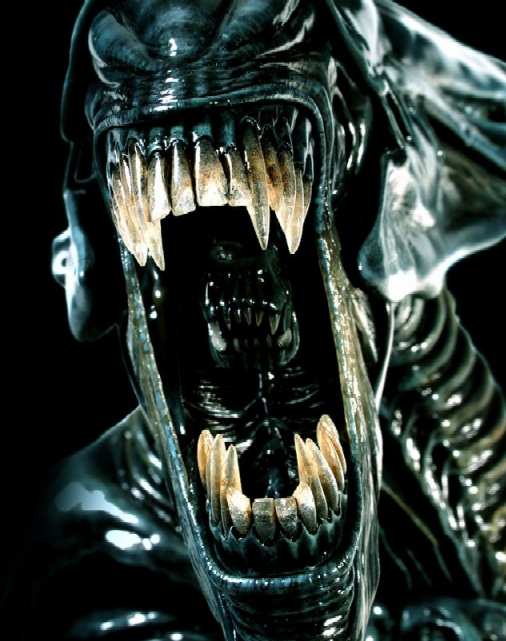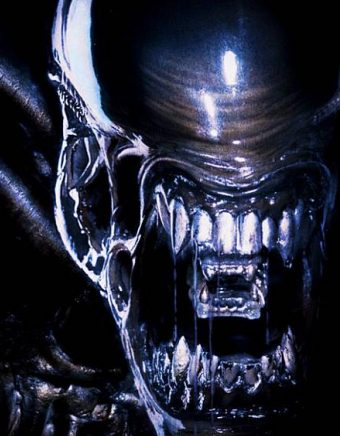|
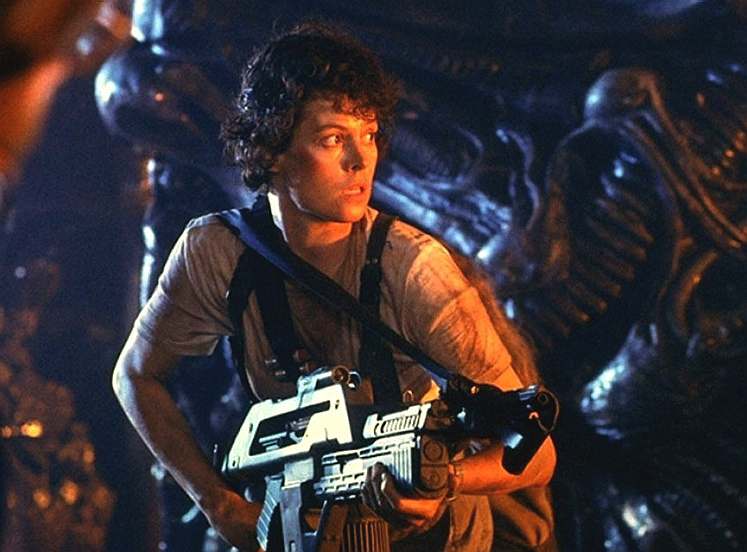
Starring
Sigourney Weaver, Ian Holm and John Hurt - this is an amazing film about
a group of interstellar miners whose ship, the Nostromo, is
diverted to a signal from an
uninhabited planet in deep space, where they find a new species
of parasitic life-form which almost kills the entire crew to
secure their species and thus infect other planets, such as earth!
When I first saw the movie at a Cinema in Brighton, I was
transfixed from the opening credits to the close. A brilliant
movie from start to finish and quality all the way, thanks to Ridley
Scott's genius behind a camera lens.
Alien is a culturally influential 1979 science fiction horror film, directed by Ridley Scott and starring
Sigourney Weaver. The title references the main antagonist, a highly aggressive and undocumented extraterrestrial life-form. During a seemingly routine investigation of an unknown planetary signal, a crew member of the space-faring towing vehicle Nostromo is attacked and infected by a young Alien. Soon, the entire crew is threatened after the creature is taken aboard Nostromo, eventually wreaking havoc.
Alien became a critical and a box-office success, spawning a Hollywood media franchise of literature, video games, merchandise and three official sequels. The film launched actress Sigourney Weaver's career. By featuring a strong heroine the film itself also proved unconventional (by Hollywood standards) for the action genre. While the Alien (referred to in spin-offs as a xenomorph) proved a popular aspect of the film, the story of Ellen Ripley became the thematic thread that ran through the series. Together with the films of David Cronenberg from the
1970s Alien emerged as a central work in the development of the body-horror
subgenre. Publicity for the film used a tagline which became famous: In space no one can hear you scream.
Sequels to the film have appeared as: Aliens (1986), Alien³ (1992) and Alien: Resurrection (1997). The 21st century saw a possible end of the Alien franchise in favor of a crossover with the Predator film series Alien vs. Predator (2004) and the upcoming sequel Aliens vs. Predator: Requiem
(2007).
Plot (original 1979 release)
The Nostromo, an interstellar commercial towing-vehicle with a crew of seven, has set out from Thedus to Earth, hauling twenty-million tons of mineral ore. At the start of the film, the ship's computer MU-TH-R 182, simply called "Mother" by the crew, receives an apparently unidentifiable signal from a moon orbiting a nearby
planet, while monitoring the ship's operations. The ship drops out of hyperspace, and "Mother" wakes the crew from stasis, so they can investigate the signal's origin. With the ore and mining facilities left in orbit, the tug portion of the Nostromo lands on the moon, suffering serious damage during the rough landing.
Captain Dallas (Tom Skerritt), Kane (John Hurt) and Lambert (Veronica Cartwright) leave the ship to investigate the signal. They soon discover a derelict spacecraft of unknown origin. The group enters the craft, finding the pilot's desiccated remains (see Space Jockey). Kane descends into a chamber beneath the pilot, discovering thousands of leathery eggs protected by a forcefield. One of the eggs opens, a lifeform inside leaps out, somehow breaks through the visor of Kane's spacesuit and attaches itself to his face. Dallas and Lambert carry the unconscious Kane back to the Nostromo. Ripley (Sigourney Weaver), the commanding officer in Dallas's absence, refuses to let them back onboard, citing quarantine protocol. However, Science Officer
Ash (Ian Holm) disregards Ripley's decision and lets them in. In the ship's infirmary Dallas and Ash attempt to remove the creature from Kane's face, but they discover they cannot remove it by force without harming Kane. When they try to cut off one of its digits, the alien's highly acidic blood sprays on the floor and burns its way through several decks of the spaceship. Due to this lethal defense mechanism, the crew cease from further attempts at removal. Eventually the creature detaches from Kane's face on its own, and the crew find it dead. Kane wakes up, seemingly unharmed.
With the ship repaired, the crew leave the moon and have one last meal before re-entering hypersleep. During the meal Kane begins to choke and convulse until an alien creature bursts through his chest. The creature then scurries away, and after ejecting Kane's body into space as a brief funeral, the crew splits up into two teams to capture it. Ash rigs together a tracking-device, while Brett (Harry Dean Stanton) assembles a weapon similar to a cattle-prod. Picking up a signal, Parker (Yaphet Kotto), Brett, and Ripley think they have the creature cornered, only to discover Jones, the crew's cat. Realizing they might pick up the cat on the tracker again later, Parker sends Brett back to catch Jones. During his search Brett encounters the alien, now fully grown and enormous. The creature attacks him with its inner jaws and hauls the paralyzed crew member into an air-shaft.
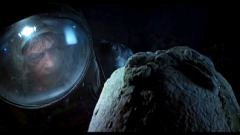
Kane examines an egg
The crew realizes that the alien uses the air-shafts to move through the ship. Dallas enters the network of air-shafts with a flamethrower, intending to drive the alien into an airlock in order to blow it out into space. Using the trackers, the crew picks up the alien's signal moving toward Dallas. Attempting to escape, Dallas runs right into the creature. His body disappears. Ripley queries Mother for advice on destroying the alien, but in the process discovers that "The
Company" had already detected the alien transmission, had decoded the signal as a warning and wanted one of the alien lifeforms brought back — ostensibly for weapons-development — even at the expense of the crew. Ash, the Company's agent on board, attacks Ripley after she learns of the "Special Order 937", but Parker and Lambert arrive before he can kill her. Parker dislodges Ash's head with a fire-extinguisher, revealing Ash as an android.
The three remaining crew members decide to destroy the Nostromo and escape in the shuttle Narcissus. While Ripley preps the Narcissus for launch, Parker and Lambert go to gather coolant for the shuttle's life-support system. Ripley hears the screams of her colleagues over the ship's communication system and runs off to investigate. She arrives too late, discovering the alien has killed Parker and Lambert. Ripley activates the ship's self-destruct sequence and races to the shuttle, but sees the alien near the shuttle entrance. After an unsuccessful attempt at aborting the self-destruct sequence, Ripley escapes with Jones to the shuttle again, with the alien nowhere in sight this time. Ripley takes off in the Narcissus, and the Nostromo explodes. While preparing for hypersleep Ripley discovers that the alien has hidden itself inside the shuttle. Ripley manages to slip on a space suit. She then blasts the alien out of the shuttle's airlock with a grappling-gun and incinerates it using the ship's engines. The film ends as Ripley and the
cat enter
hypersleep.
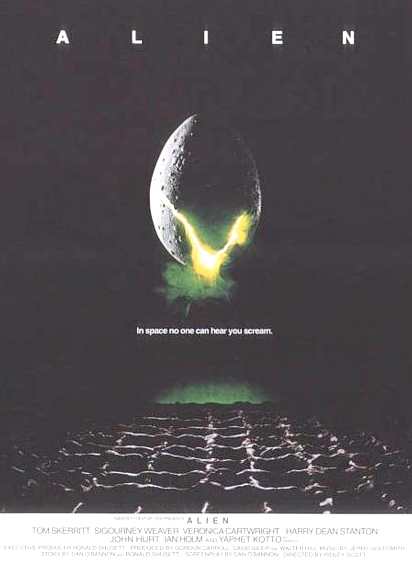
Alien
- movie poster
Cast
Casting
Actor Jon Finch originally played the role of Kane, but as principal photography on Alien commenced, the crew soon noticed that he looked ill and rushed him to hospital, where doctors diagnosed a severe case of diabetes. John Hurt, in London and available at that time, subsequently replaced Finch.
In the role of Ripley in Alien, Sigourney Weaver won her first motion-picture lead after a brief appearance in Woody Allen's film Annie Hall (1977).
Principal characters
|
Name
|
Job
|
Sex
|
Played
By
|
|
A.
J. Dallas
|
Captain
|
Male
|
Tom
Skerritt
|
|
Ellen
Ripley
|
Warrant
Officer
|
Female
|
Sigourney
Weaver
|
|
J.
M. Lambert
|
Navigator
|
Female
|
Veronica
Cartwright
|
|
S.
E. Brett
|
Engineering
Technician
|
Male
|
Harry
Dean Stanton
|
|
G.
W. Kane
|
Executive
Officer
|
Male
|
John
Hurt
|
|
Ash
|
Science
Officer
|
Android
(male)
|
Ian
Holm
|
|
J.
T. Parker
|
Chief
Engineer
|
Male
|
Yaphet
Kotto
|
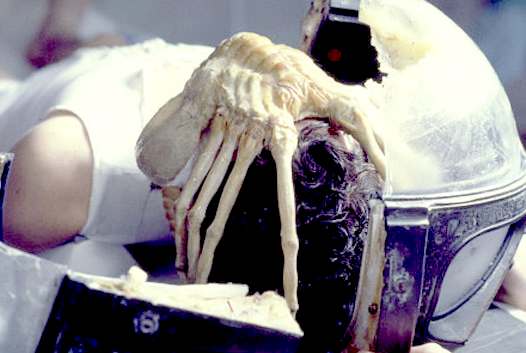
Kane (John Hurt) with creature attached to head
In several interviews supporting actress Veronica Cartwright reported that the film-crew kept details of the chestbursting scene secret from all actors except John
Hurt. Over the years this became a famous piece of Alien lore. However, on the recent Alien Quadrilogy Box DVD set actor Tom Skerrit debunks this legend and reports that he witnessed John Hurt "setting the scene up" with the film crew. He states that "they all read the script" and basically knew the whole scene, but that they didn't anticipate the intensity of the special effects, especially Cartwright, who didn't expect to be sprayed with blood and who did not act her reaction to the chestburster, but gave a genuine display of shock, disgust and horror. John Hurt reprised his famous death-scene from Alien as a parody in the film Spaceballs, groaning in despair: "Oh no! Not again!". In Spaceballs the chestburster emerges and begins to dance and sing a musical number to the song Hello! Ma Baby.
Other character crew
Name Description Played By
MU-TH-R 182 (a.k.a. "Mother") Nostromo's computer (voice; female) Helen Horton
Alien (warrior) Extraterrestrial Bolaji Badejo
Percy Edwards (Alien vocalizer)
Eddie Powell (Alien stunts)
Alien (facehugger) Extraterrestrial Ridley Scott (puppeteer)
Inspirations
Some reviewers have noted that the basic plot of Alien, the pitting of a small group of humans against a relentless alien creature in a remote location, derives from earlier science-fiction horror
films. Dan O'Bannon has over the years expressed clear views on the exact
sources. He has even gone as far as saying: "A lot of people speculated as to where I stole it from. The truth is I stole it from
everywhere."
Admitted inspirations include:
The Thing from Another World (1951), featuring the hunting of professional men (soldiers in this case) through closely confined areas.
Forbidden Planet (1956) in which a ship lands despite warnings and
a seemingly invisible creature hunts them down one by one.
It! The Terror from Beyond Space (1958) where a spaceship crew bring a murderous alien onboard who then hunts them down. Ivor Powell, the associate producer, has also highlighted the influences.
Planet of the Vampires (1965), in which humans discover the remains of a large alien sitting at the controls of its spaceship.
"Junkyard", a short-story by Clifford D. Simak:, humans find deserted spaceships on an asteroid and the crew stumble across an egg-chamber.
Strange Relations by Philip José Farmer which deals with extraterrestrial reproduction.
Various stories from Weird Tales in which monsters eat people from the inside.
O'Bannon denies influence on the part of The Voyage of the Space Beagle, which features aliens laying eggs in people which then hatch and eat their way out. However, a lawsuit brought by A. E. van Vogt ended with a settlement out of
court. Philip French suggests another non-science-fiction parallel:
Agatha Christie's And Then There Were
None.
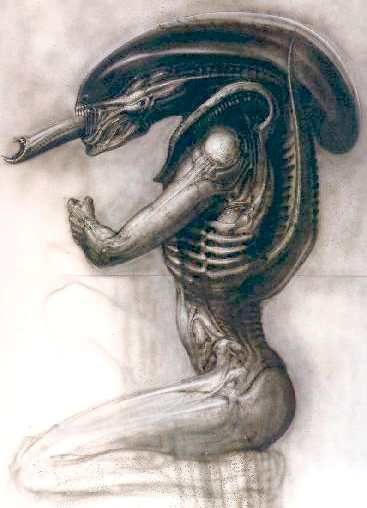
Alien
sketch by H R Giger
Production
History and early versions
According to the book "The Book of Alien" (Titan Books © 1979), a very early draft of the script envisaged the eggs housed in a completely separate architectural structure, shaped in the form of a massive
pyramid. The British illustrator and science-fiction artist Chris Foss drew these illustrations of the discarded sequence.After completing Dark Star (1974) Dan O'Bannon wanted to take some of the ideas (such as where an alien hunts a crew through a ship) and make them into a science-fiction horror film, at that time provisionally called Memory. He also worked on Gremlins (released in 1984), which features gremlins getting loose aboard a
World War II bomber and wreaking havoc with the crew (the B-17 segment of the film Heavy Metal (1981) used a significantly altered version of this original story). Screenwriter Ronald Shusett contacted O'Bannon about collaborating on projects. Although Shusett wanted input on a script that would later become Total Recall, they decided to focus on the lower-budget Memory. However, O'Bannon got drafted in to work on Alejandro Jodorowsky's adaptation of Frank Herbert's Dune. Although this came to nothing, he did meet H.R. Giger, Chris Foss and Moebius on set and a lot of their work together led to later developments when production of Alien started in
earnest. For Giger's well-recognized influence see below. Foss' spaceship designs remained unused (some later appeared in some of his books) but Mœbius's designs for the Nostromo spacesuits made it into the final
film.
When O'Bannon returned to America, broke, after the Dune film project collapsed, he ended up sharing a flat with Shusett. Shusett suggested mixing in elements of Gremlins and how the alien got on board. He said: "It screws one of the crew. Something jumps up at his face, grabs hold of him and shoves its seed down his throat, then later it bursts out." Ron Cobb had worked on the designs for Dark Star (and would later provide the bulk of the designs for Alien); he offered the idea of the creature's acid blood stopping the crew from simply blowing it up. These various ideas came together in the O'Bannon and Shusett script Star
Beast. At this stage the title loomed as the main problem. Casting around for a better name, O'Bannon noticed the number of times the word "alien" occurred in the script, and so he adopted this for the film's
title.
The original script bears many resemblances to the film as actually produced, yet with significant differences. The spaceship — designed with a low-budget production in mind — originated as a small craft, initially a galactic coastguard-like ship and then a commercial vessel, called the
Snark. In the original script, the ship has an all-male crew, including the
Ripley character (though the script's "Cast of Characters" section explicitly states that "The crew is unisex and all parts are interchangeable for men or
women"). Actor Tom Skerritt originally won the role of Ripley, but later, in the course of developing the script, character re-casting made Ripley a woman, because producer Alan Ladd, Jr., and script-doctors Walter Hill and David Giler had heard rumors of
Fox working on other titles with strong female
leads.
The script recounted how, after responding to the intercepted alien message, the crew discover the derelict alien craft and its dead pilot. Ominously, the pilot in its death-throes had scratched a triangle on its control-console. The crew members go outside and see the remains of an ancient pyramid. They lower Kane into the structure, where he finds a chamber with a breathable atmosphere. An altar-like structure houses the alien embryo-eggs, and a hieroglyph depicts the alien's
life-cycle. This concept survived for a long time, and preliminary H.R. Giger pyramid-drawings intended for Alien exist, but eventually the producers went with the idea of combining the wrecked derelict ship with the egg-chamber (also designed by Giger), although the ideas of the pyramid, the altar and the
hieroglyphs re-surfaced in the Aliens vs. Predator computer game and in the 2004 film Alien vs. Predator.
Apart from the disappearance of the pyramid, the final script changed the story's pacing. The impregnation occurred around the mid-point in the film, with a long, slow build up of tension reminiscent of the atmosphere generated in At the Mountains of Madness. It also ended with an Alien
egg seen clinging to the bottom of the escaping shuttle, a detail that survived various drafts and disappeared only in the final version dated June
1978.
The original cut of the film also included a scene where, after the attacks on all her fellow crew-members, Ripley heads towards the shuttle, then stumbles across a room where she finds Dallas — barely alive — and Brett (Dallas and Brett, the first two crew-members to fall victim to the Alien, had disappeared). Dallas and Brett, cocooned in mucus, have apparently started mutating into alien eggs. Dallas begs Ripley to kill him, and she does so by using her flamethrower device. Although editing removed this scene from the final theatrical cut, the idea emerged later in scenes in Aliens, Alien Resurrection and Aliens vs. Predator.
Pre-production
O'Bannon and Shusett almost completed the sale of the film to Roger Corman. However, at the last minute, their friend Michael Haggerty said he could get them a better deal; and thus they sold the script to the Brandywine company of David Giler, Gordon Carroll, and Walter Hill, who had a production-deal with Twentieth Century Fox with Hill attached to
direct. A single tagline promoted the script to studio executives: "Jaws in
space".
Hill and Giler re-wrote the script, making it more action-oriented, adding the character of Ash, and rewriting much of the dialogue. They also introduced a motherhood theme, though the detail of Ripley going back for the cat originated in the period of the male
Ripley-character. These changes caused tension between O'Bannon and the other production members that lasted through the making of the film. Parts of O'Bannon's scripts appear on various DVD releases, with the full early version presented on the Alien Quadrilogy.
At this stage, a hiatus occurred in the production, as the studio expressed alarm at the prospect of committing to a new science-fiction film in the pre-Star Wars era when such films remained a
rarity.
When Star Wars became a box-office hit, Fox gave the film the go-ahead with an $8 million budget — much higher than the writers had originally hoped. During the production hiatus, Ridley Scott replaced and revised many of the design-elements before principal photography started at Shepperton Studios in
England. Giger, brought in from
Zürich (Switzerland), set up at the studios along with Ron Cobb as a type of artist-in-residence. (Giger kept a diary through the production which became the basis for his book Giger's
Alien).
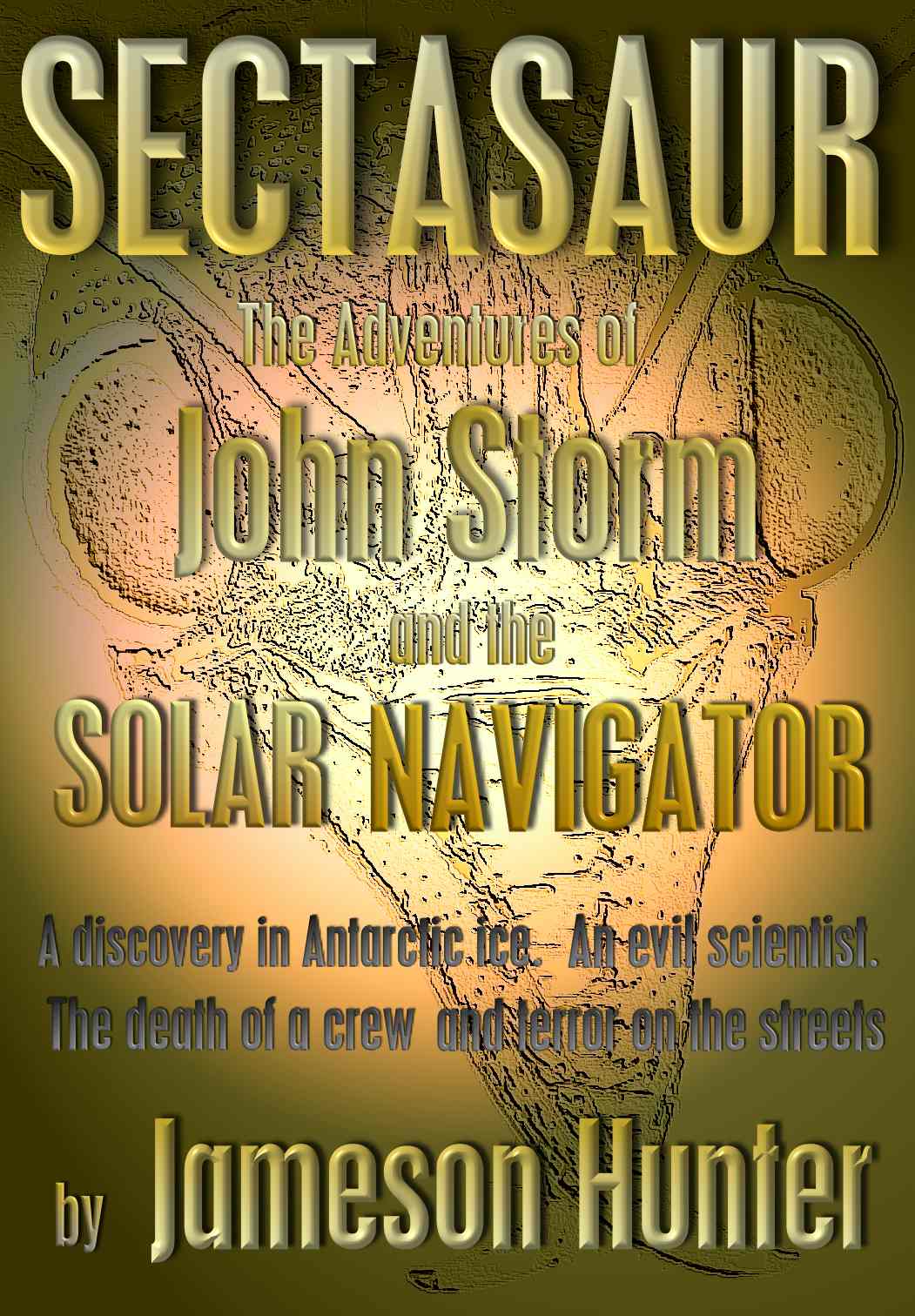
The alien
H.R. Giger's original design for the Alien, based on his earlier work, Necronom IVSwiss painter and sculptor H. R. Giger designed the alien creature's adult form and the alien architecture. The designs feature the creative use of bones in the architecture (the set constructors used real bones in making the interior of the alien ship). Giger received an Academy Award for his work on the original film. The design of the creature with strong Freudian
sexual undertones and multiple phallic symbols, while simultaneously presenting an overall feminine figure, provided a compelling androgynous image, conforming to archetypal mappings and imageries in horror films that often redraw gender
lines.
The adult alien appears predominantly black in color, similar in cast to heavily tarnished silver. In keeping with Giger's blending of biological and mechanical life-forms, some shots reveal a metallic patina. It has an elongated shiny head with no eyes. (Some production stills reveal a human skull used in the sculpture beneath its translucent anterior shell). Below, the jaw holds the razor-sharp metal teeth. The mouth houses a tongue-like body part with a second mouth on the end. On the alien's back stand four curved black pipes (Giger designed these for the purpose of breaking up the back). Apart from this, the alien has an anthropomorphic form, with two legs and two arms, its hands each armed with six long, black, razor-sharp claws. The "blood" of the creature, a powerful acid, also serves as a natural defense mechanism.
The slime of the costume would eat through the paint, so it needed repainting every
day. Giger's original design for the alien facehugger changed, as it resembled a twisted rubber chicken and looked more comical than scary.
Set design and construction
Michael Seymour worked as the film's production designer. John Mollo supervised the costumes, including the distinctive spacesuits, and Carlo Rambaldi produced the crucial mechanical effects for the title-alien's head. The team of Brian Johnson and Nick Allder — who had worked on 2001: A Space Odyssey and Space 1999 — headed up special effects. Scott turned to a computer-animation pioneer, Bernard Lodge, from his old college — the Royal College of Art in London — to produce the film's green-line computer displays. The thin layer of mist that "notified the eggs" came from smoke and a pulsating
laser, which the film crew borrowed from the band The Who.
According to the behind-the-scenes documentary The Beast Within: The Making of "Alien", the film crew built the spaceship set in one piece. To move around the set, actors had to navigate through the hallways of the ship. Toward the end of the shoot, many members of the cast and crew recalled walking inside the set alone as a very unnerving experience. Some maintain that such emotions come across on the screen.
Some shots outside the Nostromo on the surface use children in spacesuits (specifically Ridley Scott's and the cameraman's children) as stand-ins in order to make the spaceship's landing-legs seem larger. Ridley Scott says in the director's commentary on the DVD, "This shot here, actually is three children made in miniature spacesuits... who were my two sons and the cameraman's son... I had small costumes made for them so the landing legs looked
bigger..."
Ridley Scott re-used the Nostromo's and the shuttle's computer-graphics, specifically the PURGE-screen, for the computer-screens inside the Spinner hover-cars in his film Blade Runner.
Other filming has re-used the set. In particular, the BBC One series of The Hitchhiker's Guide to the Galaxy re-used some of the Nostromo hallways, as well as other parts of the set. These appear most prominently in the scenes set onboard the Vogon Constructor
Fleet. When the BBC science-fiction sitcom Red Dwarf moved production to Shepperton Studios it used some surviving Nostromo hallway sets from Alien in Series 5, most notably in the episode "DNA" (as revealed on the DVD commentary).
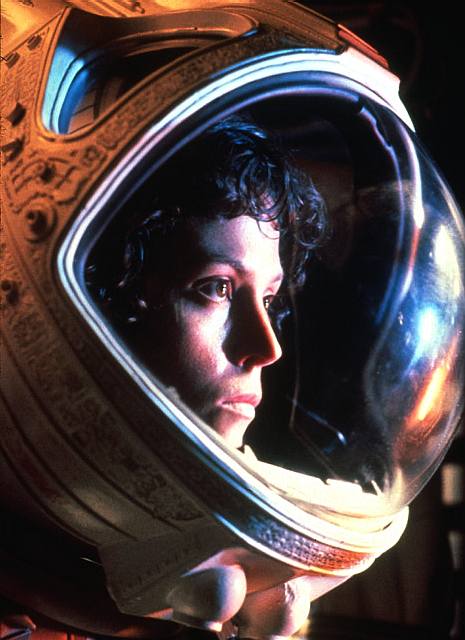
Music
Ridley Scott's vision of the film came under the influence of Isao Tomita's synthesizer-arrangement of Holst's The Planets, especially of the movement "Mars: Bringer of War", and at one point in pre-production Tomita appeared a serious candidate to write the original score for the
film. With the dropping of these plans, however, Jerry Goldsmith came to compose the film music. Instead of aiming at a typical 1970s science-fiction score utilizing
synthesizers, the composer's music reflects the film's underlying horror-film genre with its use of bleak orchestrations, most notably in the higher woodwinds, oscillating string-textures and bizarre, sometimes savage sounds, especially from the brass-section, which his orchestrator Arthur Morton built from the orchestral palette with various modern compositional techniques. Goldsmith also composed a main theme in the romantic style that barely appears in the finished film. A short passage from Eine kleine Nachtmusik by Wolfgang Amadeus Mozart also plays as source music during the scene in which Dallas spends some time alone relaxing in the shuttle Narcissus.
Director Ridley Scott and editor Terry Rawlings became quite attached to several of the pre-existing cues that they had used for the temporary score while editing the film. As a result Scott and music editor Robert Hathaway moved around much of Goldsmith's score, re-edited cues and re-scored several sequences. In some parts of the film the temp score remained in
place: segments of four monaural cues from Goldsmith's 1962 score for Freud – The Secret Passion appear in the
film, and the final minutes of the Adagio of Howard Hanson's Symphony No. 2 "Romantic" replaced Goldsmith's music for the concluding moments of the film's showdown, as well as the complete music for the end credits. As a result, Goldsmith's original soundtrack LP represented more the original score he wrote than what ended up appearing in the film.
As an additional feature the initial 20th Anniversary Edition DVD of Alien included both an isolated music-only soundtrack that restored the cue-order originally envisioned by the composer,
re-synchronizing the cues to their appropriate places, as well as a second isolated film-music soundtrack with the re-scored and re-arranged cues from the official 20th Century Fox release of the film, while the full production soundtrack played between music cues. In the final DVD release most of the scenes showing the Nostromo exterior and all of the sequences from Howard Hanson's second symphony ("Romantic"), some of which went along with them, have disappeared for reasons unknown.
The original film score by Jerry Goldsmith played under the conductor's baton of Lionel Newman, who also received main-title credits, a practice that had become unusual by the time of the film's release. The National Philharmonic Orchestra played the music. The soundtrack CD of Alien has now gone out-of-print. Over the years several bootlegged copies of Goldsmith's score appeared on the market, among them a Spanish two-CD release with all used and unused cues, including the retained temp score, and an archive bootleg that also included alternate takes from the recording sessions.
In 1980 Jerry Goldsmith's film music for Alien received nominations for the Golden Globe Award (Best Original Film Score), the Grammy Awards (Best Album of Original Score Written for a Motion Picture or Television Special) and the Anthony Asquith Award for Film Music.
Official soundtrack releases
Original soundtrack (Fox Music, 1979; LP; 10 tracks)
Re-issue of the original soundtrack (Silva Screen Records, 1987; CD; 10 tracks)
The Alien Trilogy (Colosseum, 1996; CD; 13 tracks, incl. 7 tracks from the original Alien soundtrack)
20th Anniversary Edition DVD containing two isolated music tracks: a) the original score and b) the alternate music track (Fox Home Entertainment, 2000)
In addition several compilation re-issues and re-recordings of some of Goldsmith's music for Alien have
appeared.
Bootleg releases
"Limited library archival pressing" (Soundtrack Library, 1999; CD-R; 32 tracks; allegedly including alternate takes from the recording sessions)
Alien: First Release of the Complete Score from the Stereo Master Tapes (Total Sound, 2000; CD-R; 21 tracks; assembled from the production of the 20th Anniversary Edition DVD)
Alien: Banda Sonora Original del Film y Temas Rechazados (Memory Records, 2001; 2-CD release; 25 + 21 tracks; including rejected cues, temp score cues and bonus material)
"Director's Cut bootleg" (Nostromo Enterprises, 2006; 2-CD release; 30 + 25 tracks; in most parts a re-assembly of preceding bootlegs and official releases and compilations, including re-masters from the production of the Alien special edition DVD and the soundtrack for Iwerk's Aliens: Ride at the Speed of Fright by composer Richard Band)
Influence
In film
Roger Ebert called Alien (and John Carpenter's Halloween) "the most influential of modern action pictures". He went on to say that many of "the films it influenced studied its thrills but not its thinking", including the re-make of The Texas Chainsaw
Massacre. Andrew O'Hehir wrote, "almost every horror film since Alien has ripped it off in some way, but most of the imitations have focused on
details."
In 1980, Italian director Ciro Ippolito made an unauthorized sequel called Alien 2 sulla Terra.
Commentators point to Alien, along with The Brood and other films (see above), as launching the body-horror sub-genre of horror film. Also, the film's cramped, claustrophobic sets have become the de facto norm for many science-fiction films and horror films set in space, which also changed visual aesthetics in otherwise slick science-fiction franchises such as
Star Trek, e.g. in the depiction of the Borg environment. Alien's representation of the ship's crew has also had a huge influence. For the first time, a blockbuster science-fiction film depicted space-travelers as blue-collar company employees (or "space jockeys") rather than as highly-empowered agents of a military-styled entity (such as in Star Trek or Star Wars). (A hint of this also appeared in earlier films such as Silent Running (1971) and John Carpenter's 1974 film Dark Star.) Apart from the dark aesthetics the film Outland (1981) borrows much of this premise, as did the British TV science-fiction comedy Red Dwarf (which also appropriated a good deal of the aesthetics), and across the genre the aesthetic of Alien for future technology became the norm in the following
decade.
On television
On the DVD commentary for The End, the first episode of the British science fiction series Red Dwarf, Doug Naylor, Rob Grant, and Ed Bye cite Alien as an inspiration for the show.
On an episode of The Simpsons, "Sweet Seymour Skinner's Baadasssss Song", Principal Skinner watches Groundskeeper Willie track Santa's Little Helper in the air ducts in a similar fashion to the way in which the Alien chases Dallas.
In Stargate: Atlantis in the episode Doppelganger, Drs. Keller and McKay, along with Teyla and
Ronon, discuss their experiences seeing the movie.
On video games
The aliens in Contra greatly resemble the Alien. Also, one of the bosses in the original game has close echoes of the Space
Jockey.
The game Xenophobe features creatures very similar to the Alien, including acid blood and a facehugger. Also in Starcraft, the heads of the creatures known as Hydralisks resemble the Alien's skull.
The Half-Life modification Natural Selection features some points that nod towards the Alien universe. For example: it features alien enemies named "Xenoforms", the soldiers resemble the United States Colonial Marines from Aliens, and several in-game maps resemble those from the Alien franchise. Also, the headcrabs in Half-Life resemble the face huggers of the Alien universe.
The game Duke Nukem 3D includes several references to Alien, including nearly identical eggs from which face-sucking creatures emerge, and resin-encased humans who whisper "Kill me."
The game Metroid contains a key boss character called 'Ridley', a nod to director Ridley Scott. The title parallels other elements from the movie as well, including climactic self-destruct countdowns, egg-hatching extraterrestrials, a main antagonist named after Alien's 'Mother' computer, and a female lead character (in reverence to Alien's Ripley) called Samus
Aran.
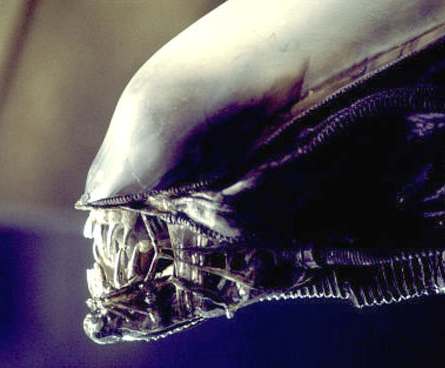
Alien
preparing to strike
Gender-politics
Analysts have examined the film's gender-politics and its influence on the subsequent development of the leading heroine in Hollywood
film, also noting that the film's narrative broke with the prominent custom of repressing female roles in science-fiction films, since the woman, representing nature, biology and sexuality, normally functioned as an antagonistic, ridiculing signifier of science and
technology. Some critics see the non-traditional re-interpretation of the female lead in Alien as a necessity, since only a female, (i.e. "natural") entity can successfully fight the anti-technological, biologically reproducing and overly sexualized xenomorph in a science-fiction environment. Nevertheless, the character of Ripley remains a prime example of the final girl, an archetype of many horror-film plots, signified by purity, virginity and gender fluidity, meaning a subsequent masculinization in the course of the story.
The film received some academic attention and commentators linked it to wider cultural idioms, especially those popular in the 1970s and 1980s such as
abjection. James Kavanaugh criticized the film's "internally overdetermined and contradictory construction" in disguising humanist ideologies as
feminism. Film-critic Kathleen Murphy called Kavanaugh's analysis an assaulting, "academically approved
gobbledygook". Several academic theses on the film, which matured over the following years, appeared in print in the book Alien Zone: Cultural Theory and Contemporary Science Fiction
Cinema.
James Cameron's 1986 sequel Aliens revived academic interest in the Alien film series, because he had deviated from the individual and progressive 1970s model of the film heroine and had presented a conservative, maternal and familial interpretation of the character Ripley, while simultaneously and consequently mirroring this development with the introduction of the maternal alien queen as an adequate opponent.
Merchandising
Alien became the first R-rated film to have a merchandising line aimed at children. The children's products released included various toys and models based on the creature and on its egg, jigsaw puzzles, a board game, a Viewmaster-style movie reel, and even a storybook, all of which rate as collectible today. Most notably, Kenner Products released an 18-inch Alien figure, impressively made (for its time) with articulated parts including the retractable jaw and glow-in-the-dark cranium. However, the toy did not sell well, probably because its target demographic failed to recognize it and parents deemed the toy too frightening for
children. No models of the Nostromo space-vessel reached the market.
Toy-lines for R-rated films would not become common until the
1990s. At the time, Kenner's decision to do a toy-line based on Alien came before the release of the film. Due to their success with the other 20th Century Fox film, Star Wars, Kenner Products admittedly acted on the assumption that Fox would produce another space-adventure film: their research failed to ascertain that the horror-oriented Alien would target adults.
Awards and accolades
Alien won the 1979 Academy Award for Best Visual Effects and also received a nomination for Best Art Direction-Set Decoration.
The Academy of Science Fiction, Fantasy & Horror Films, USA named it the Best Science Fiction Film of the year and Ridley Scott Best Director, and it won the Hugo Award for Best Dramatic Presentation.
In 2002, the United States National Film Registry deemed the film "culturally, historically or aesthetically significant" and inducted it into its collection.
In 2007 Empire Magazine named the "chestburster" scene in Alien the greatest 18-rated movie moment ever as part of its 18th birthday
issue.
Special Edition (2003)
October 29, 2003 saw the re-release of Alien in cinemas as a Ridley Scott Director's Cut. This release restored many but not all of the deleted scenes, which had already appeared as bonus materials on previous VHS, laserdisc and DVD releases of the film, and made unobtrusive deletions to the original. The new release also added some minor visual effects to the film: a shot of the sunrise on the moon, lights on the helmets of Dallas, Lambert and Kane moving under a natural arc on the alien moon as well as a field of stars in the background, when the Nostromo synchronizes its orbit around the moon.
Ridley Scott stated that Alien didn't require this tweaking and drew attention to the use of the term "Director's Cut" for marketing reasons only (and inconsistently as well). In the Alien Quadrilogy DVD materials, he goes out of his way to state his preference for the original: "Rest easy, the original 1979 theatrical version isn't going anywhere." He re-edited the film himself, but only after viewing the studio's attempt to do so. He has characterized the studio's initial version as "too long" and felt that it ruined the film's pacing.
The Alien Quadrilogy boxed set released on December 2, 2003 includes both the Special Edition and the original theatrical version. Because the new version slightly shortened many of the scenes and shots from the original release and edited them with discreet acceleration to pander to modern film-audiences' viewing
habits, the Special Edition actually runs forty seconds shorter than the original 1979 theatrical
release, despite the addition of almost six minutes of new
material.
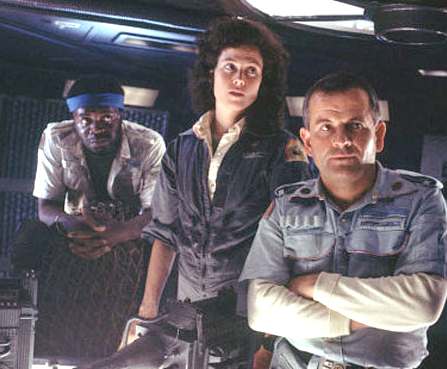
Parker,
Ripley and Ash onboard the Nostromo
The cocoon scene
The 2003 Special Edition also featured the infamous "missing scene from Alien", in which Ripley, before activating the Nostromo's self-destruct, enters the Alien's nest on her way to the shuttle. There she finds two of her crew mates cocooned in the creature's hardened saliva, mutating into alien eggs: a lifeless and almost unrecognizable Brett; and a dying Captain Dallas, who begs of Ripley to kill him with her flamethrower. This she eventually does before continuing toward the shuttle.
For the original 1979 release of Alien, Ridley Scott and the film's producers had still opted for a removal of the scene, because they felt that it destroyed the pacing of the film's
climax. The omission of the "cocoon scene" allowed James Cameron to extend the xenomorph's life cycle for the sequel Aliens and to introduce the concept of the alien hive built around the alien queen. The re-insertion of the "cocoon scene" into the Special Edition of Alien breached the factual life-cycle canon introduced in Aliens, because the scene implies that a rogue alien warrior can reproduce without the presence of an alien
queen.
This original alien life cycle theory had its origins in a proposal by screenwriter Dan O'Bannon. Prior to the release of the Special Edition only Foster's novelization implied it: there the cocoon (including the victim) slowly mutated into an alien egg that would eventually give birth to a new
facehugger. Some fans considered O'Bannon's theory as canon and criticized James Cameron's revised alien life-cycle in the sequel Aliens (where the alien queen has the duty of laying the eggs) as disregarding this alleged canon. In a 1992 issue of Starlog magazine Cameron explicitly answered some of the fans' accusations and questions, stating that a scene missing from a film, with its interpretation and intention known only through a film's novelization, would not suffice as canon and would overly restrict him as a
storyteller.
Spin-offs
The novelization by Alan Dean Foster appeared in 1979. It includes dramatizations of most scenes, also the scenes found in the Special Edition (but notably excluding the "Space Jockey" scene) as well as scenes scripted but never filmed, or filmed but never included in any release version of the film. Notably, the novelization includes the discovery of the radio-transmitter aboard the derelict, a moment when the surviving crew-members contemplate taking suicide pills and the detection of the alien as it searches for food in one of the Nostromo's storage-chambers. One of the most infamous episodes however, and one which the crew only partially filmed, involved a failed attempt to blow the alien out of an airlock, which does not succeed because — as Foster implies — the character Ash intervenes by sounding the ship's alarm to scare the alien away from the airlock. In addition, the characters Ripley and Dallas become suspicious of Ash's intentions after this incident. For many years Foster's novelization provided fans and others with the only known source for the "missing cocoon scene from Alien" (see also above).
Subsequent spin-offs include comics, novels, and computer games. Alien itself received a comic-book adaptation by writer Archie Goodwin and artist Walter Simonson called Alien: The Illustrated Story, published by the Heavy Metal magazine, promptly followed by Alien: The Movie Novel, a photographic film-novel as well as a miscellaneous behind-the-scenes book called The Book of Alien. However, the franchise failed to soar before the release of Cameron's sequel and the subsequent adaptations by Dark Horse Comics in the late 1980s. The Aliens have since also appeared in numerous comic-book crossovers featuring Predators, Superman, Batman, WildC.A.T.s, Green Lantern, Judge Dredd and others.
Aliens is a 1986 science fiction/action/horror starring Sigourney Weaver, Michael Biehn, Lance Henriksen, Carrie Henn, Bill Paxton and Paul Reiser. A sequel to Ridley Scott's 1979 film Alien, Aliens takes place 57 years after the events of the first film and is regarded by many as a benchmark for the action and science fiction
genres. In Aliens, Weaver's character Ellen Ripley returns to the planet where she first encountered the hostile Alien "xenomorph." This time she is accompanied by a unit of Colonial Marines.
Directed by James Cameron from a story written by Cameron, David Giler and Walter Hill, Aliens is a high-paced action-adventure film which is in stark contrast to the suspenseful Sci-Fi horror of the original Alien. Following The Terminator, the film helped to establish Cameron as a major action
director. Sigourney Weaver received her first Best Actress Academy Award nomination for her leading role in
Aliens. Like its predecessor, the film was shot in England, this time at Pinewood Studios, with a budget of approximately $18
million. The film went on to earn over $131 million internationally during its 1986 theatrical release, making it the highest-grossing entry in the Alien film
series. Given the combat-oriented nature of the film, Aliens was promoted with the tagline, "This Time It's War."
Plot
Ellen Ripley, the only survivor of the Weyland-Yutani Corporation space freighter Nostromo, is rescued and revived after drifting for 57 years in hypersleep. Interviewed before a panel of company executives, Ripley's testimony regarding the Alien is met with extreme skepticism, as no physical evidence of the creature survived the destruction of the Nostromo. Ripley is informed that LV-426, the 'planetoid' where the Nostromo crew first encountered Alien eggs is now home to a terraforming colony. Between shifts at her new job loading cargo, Ripley is visited by Weyland-Yutani employee Carter Burke, who informs her that telecommunications contact has been lost with LV-426: the company is dispatching Burke and a unit of Colonial Marines to investigate. Despite severe misgivings, Ripley accepts an offer to join the expedition. Arriving in orbit of LV-426 aboard the warship Sulaco, she is introduced to the Marines, including the novice lieutenant Gorman, the veteran sergeant Apone and the android Bishop. Ripley gives an emotional account of her original encounter with the Alien to the unit, but her warnings are dismissed by the cocky soldiers.
The heavily-armed expedition descends to the planetoid's surface via dropship. They find the colony seemingly abandoned; the only living things are two of the Alien-implanting "facehuggers" on display in the colony's medical lab, and a severely traumatized young girl, nicknamed Newt, who has survived by hiding in the colony's sprawling ventilation system. The Marines eventually locate the other colonists, by tracking their surgically-implanted transceivers, clustered together in the colony's nuclear-powered atmosphere-processing station. Traveling to the station, the Marines find a large Alien nest, filled with the cocooned corpses of the colonists. When the Marines destroy a newborn chestburster-Alien, a swarm of mature Alien drones awakes and ambushes the unprepared unit. Most of the unit is killed or captured; Ripley crashes their APC into the nest, knocking Gorman unconscious but rescuing Corporal Hicks, Private Vasquez, and Private Hudson. Hicks assumes command of the mission and orders the dropship to recover the survivors, with the intent of returning to the Sulaco and destroying the colony from orbit, but a stowaway Alien kills the dropship pilots in flight, causing the vessel to crash into the processing station. The surviving humans barricade themselves inside the main colony complex.
Ripley learns that Burke has ordered Bishop to preserve Alien specimens for return to the Company labs. She confronts Burke and declares that after investigation she has discovered it was he who sent the unprepared colonists to the original Alien-infested spaceship; she vows to expose him. Bishop shows them that the damaged nuclear processing station has become unstable and will soon detonate with the force of a thermonuclear weapon. Having no other way to contact the second dropship still onboard the Sulaco, he volunteers to crawl down a service pipe to the colony transmitter array and bring the vessel down by remote control. A recovered Gorman rejoins the team, while Ripley and Newt try and get some rest. Ripley awakens to find they have been locked in the room with the two live facehuggers. She sets off a fire alarm which alerts Hicks, Hudson, and Vasquez, who arrive and destroy the creatures. Ripley accuses Burke of releasing the facehuggers with the intention of using her and Newt as hosts to smuggle the implanted Aliens past quarantine. The debate about what to do with him is interrupted when the power to headquarters is cut off, possibly by the Aliens, who pour in through a gap in the ceiling and attack en masse. During the battle Hudson is swarmed and pulled down through the floor, while Burke's attempt to flee alone is quickly cut short by one of the attackers. Newt leads the few remaining members into the air ducts. Gorman and an injured Vasquez, after being cut off and surrounded, detonate a grenade, killing themselves and several Aliens. The force of the blast pushes Newt down a shaft, where she is captured alive by an Alien.
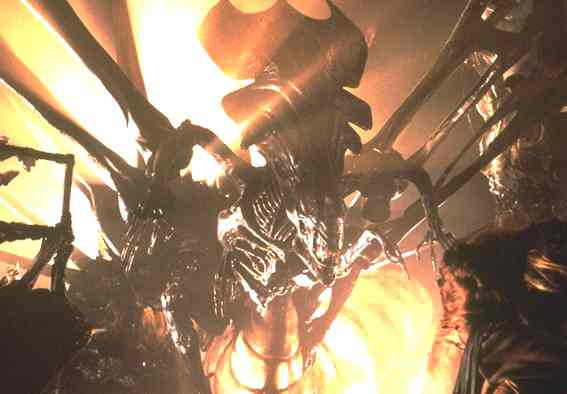
The alien queen in the atmosphere processor
hive
Hicks is badly injured by the acidic blood of one of the Aliens while reaching Bishop and the second dropship. Ripley, unwilling to leave Newt, gears up to rescue the girl. She finds and frees a cocooned Newt in the bowels of the Alien hive, but while attempting to escape, they stumble into the nest's main breeding chamber, where they are confronted by the monstrous Alien queen. Ripley incinerates the chamber with her weapons--draining the last of her ammo and enraging the queen, who escapes the destruction by tearing free from her huge ovipositor. Closely pursued by the queen, Ripley and Newt rendezvous with the dropship and escape moments before the entire colony is consumed by the nuclear blast from the processing station. Back on the Sulaco, Ripley's and Bishop's relieved conversation is abruptly interrupted when the queen, stowed away on the dropship landing gear, impales the android from behind with her barbed tail and then tears him in half. Ripley distracts the queen long enough for Newt to jump into a hole in the ship's deck plating. Just as the queen is about to pull the girl from her hiding place, Ripley reappears manning one of the ship's exosuit "power-loaders". She battles the queen and succeeds in dropping the creature into a large airlock and expelling her into space. Ripley, Newt, Hicks and Bishop enter hypersleep for the return back to Earth.
Cast
Military Personnel
|
Name
|
Occupation
|
Gender
|
Played
By
|
|
Bishop
(341-B)
|
U.S.S.
Sulaco's XO
|
Android
(Male)
|
Lance
Henriksen
|
|
1stLt.
William Gorman
|
Marine
(Commanding Officer)
|
Male
|
William
Hope
|
|
GySgt.
Al Apone
|
Marine
(Senior Non-Commissioned Officer/First Squad Leader)
|
Male
|
Al
Matthews
|
|
Cpl.
Dwayne Hicks
|
Marine
(Junior Non-Commissioned Officer/Second Squad Leader)
|
Male
|
Michael
Biehn
|
|
Cpl.
Collette Ferro
|
Marine
(Dropship Pilot)
|
Female
|
Colette
Hiller
|
|
Cpl.
Cynthia Dietrich
|
Marine
(Corpsman)
|
Female
|
Cynthia
Dale Scott
|
|
Pfc.
William Hudson
|
Marine
(Technician)
|
Male
|
Bill
Paxton
|
|
Pfc.
Jenette Vasquez
|
Marine
(Smart Gunner)
|
Female
|
Jenette
Goldstein
|
|
Pvt.
Mark Drake
|
Marine
(Smart Gunner)
|
Male
|
Mark
Rolston
|
|
Pvt.
Daniel Spunkmeyer
|
Marine
(Dropship Crew Chief)
|
Male
|
Daniel
Kash
|
|
Pvt.
Ricco Frost
|
Marine
|
Male
|
Ricco
Ross
|
|
Pvt.
Tim Crowe
|
Marine
|
Male
|
Tip
Tipping
|
|
Pvt.
Trevor Wierzbowski
|
Marine
|
Male
|
Trevor
Steedman
|
Civilians
|
Name
|
Occupation
|
Gender
|
Played
By
|
|
Ellen
L. Ripley
|
Former
Warrant Officer, Xenomorph Advisor
|
Female
|
Sigourney
Weaver
|
|
Rebecca
“Newt” Jorden
|
Colonist
(Child)
|
Female
|
Carrie
Henn
|
|
Carter
J. Burke
|
Weyland-Yutani
Corporate Lawyer
|
Male
|
Paul
Reiser
|
|
Paul
Van Leuwen
|
Chairman
of the Interstellar Commerce Commission
|
Male
|
Paul
Maxwell
|
|
Ann
Jorden
|
Colonist
(Salvager)
|
Female
|
Holly
De Jong
|
|
Russ
Jorden
|
Colonist
(Salvager)
|
Male
|
Jay
Benedict
|
|
Tim
Jorden
|
Colonist
(Child)
|
Male
|
Christopher
Henn
|
|
Al
Simpson
|
Colonist
(Operations Manager)
|
Male
|
Mac
McDonald
|
|
William
Lydecker
|
Colonist
(Assistant Operations Manager)
|
Male
|
Bill
Armstrong
|
|
Mary
|
Colonist
|
Female
|
Barbara
Coles
|
Other
cast
|
Name
|
Occupation
|
Gender
|
Played
By
|
|
ECA
Rep
|
Extrasolar
Colonization Administration Representative
|
Female
|
Valerie
Colgan
|
|
Insurance
Investigator
|
|
Male
|
Alan
Polonsky
|
|
Medical
Technician
|
Gateway
medical staff
|
Female
|
Alibe
Parsons
|
|
Doctor
|
Gateway
medical staff
|
Male
|
Blain
Fairman
|
|
Amanda
Ripley
|
Civilian
|
Female
|
Elizabeth
Inglis
|
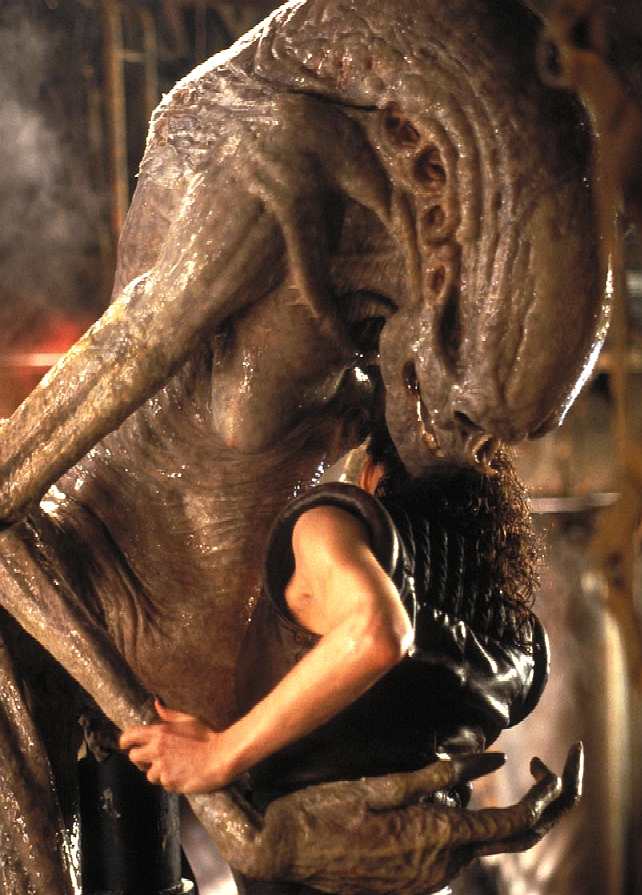
Inspirations
Director James Cameron drew inspiration for the Aliens storyline from the Vietnam War, with regards to situations where a technologically superior force was mired in a hostile foreign
environment. The name of the Colonial Marines' ship, "Sulaco",
is the name of the town in Joseph Conrad's Nostromo, which was the name of the ship in Alien. Cast members in the role of the Colonial Marines were also instructed to read Robert Heinlein's Starship
Troopers.
Some critics have compared the Alien Queen to Grendel's mother in
Beowulf.
Production
History and pre-production
In 1983, while completing The Terminator, director James Cameron discussed the possibility of working on a sequel to the original 1979 Alien with Twentieth Century Fox producer David Giler. A big fan of the original film, Cameron was highly interested in crafting a sequel, and entered a self-imposed seclusion to brainstorm the concept for "Alien
II." After four days, Cameron had produced an initial story treatment for the film which eventually became
Aliens. Following the success of The Terminator, Cameron and partner Gale Anne Hurd were given approval to direct and produce the sequel to Alien, scheduled for a 1986 release.
Sigourney Weaver, the star of the original film, was hired for the sequel with a salary of
$1 million, thirty times her fee for the first
film. Weaver nicknamed her character "Rambolina," and stated that she approached the role as akin to Henry V or women warriors in
Chinese classical
literature.
Production disputes
The producing team behind Aliens, James Cameron and Gale Ann Hurd.
The production of Aliens was affected by a number of personnel and cast
disruptions. Shooting was said to be problematic due to an apparent lack of cooperation between Cameron and the British crew, with the crew having what actor Bill Paxton called in his audio commentary a "really indentured" way of working, which infuriated Cameron, who is known to be a very hard driving director, and at the time was bound to a low budget with a release date set that he couldn't delay, while the crew members seemed to be dragging their
feet. The crew reportedly disliked him in part because he was not British, and they were all admirers of the previous director
Ridley Scott, and many believed Cameron to be too young and inexperienced to be directing such a film as Aliens, despite Cameron's attempts to show them his previous hit, The Terminator, which they refused to
watch.
At one point, the crew members mocked Cameron's then wife, producer Gale Anne Hurd, by asking her who the producer of the film was, and then laughing at her and insisting she was only getting the producer credit because she was Cameron's wife. Ultimately, a walkout occurred when Cameron clashed with an uncooperative camera man who refused to light a scene the way Cameron
wanted. Specifically, the camera man believed in creative input on set lighting, and had lighted the alien nest in a bright manner, while Cameron insisted on his original vision of a dark, foreboding alien nest
set. After the camera man was fired, Hurd managed to coax the crew members into coming back to work.
It was not uncommon for the English "tea trolley" - a mobile snack bar containing tea, beverages, and other food items
- to interrupt the filming of the movie during tea time. These interruptions further enraged Cameron and were viewed as more distractions to the completion of
filming.
Actor James Remar was originally cast as Corporal Dwayne Hicks, but was replaced by Michael Biehn after a falling out with Cameron. Remar can still be seen in a shot where the
marines are entering around a corridor, but since he is in full armor and seen only from behind, it is impossible to tell that it is Remar and not
Biehn.
Set design and construction
Some of the scenes inside the alien nest were shot inside the disused power station in Acton, West
London. The Alien nest set wasn't dismantled after filming. It was unused until three years later when it was used as the Axis Chemicals set for
Batman in 1989. When the crew of Batman first entered the set, they found most of the Alien nest still
intact.
As the marines explore the complex, they look up and see what appears to be a series of vents. These were the backs of old television sets pushed into service by the special effects team.
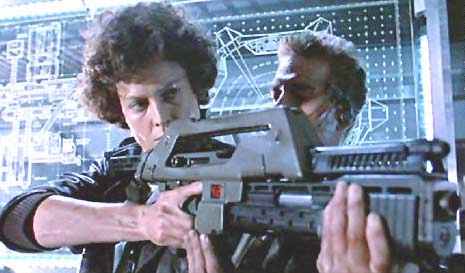
Ellen Ripley wielding a pulse rifle in
Aliens
Weapons and props
The weapons used by the marines are all based on real, fully functional
weapons. The M41A pulse rifle is made from a Thompson SMG with an attached fore end from a Franchi SPAS-12 shotgun, a Remington 12 Gauge Model 870P receiver with barrel while the smartguns carried by Vasquez and Drake are based around the MG-42 machinegun, and are maneuvered with the help of a steadicam camera
harness. The pistol that most Marines carried was the futuristic Heckler & Koch VP70 9mm, and Vasquez carried a Smith & Wesson Model
59. The Colonial Marine Armour was made by specialist Film armourer Terry English. It is now highly sought after by collectors (and very
expensive).
After the movie's premiere, the Caterpillar construction equipment company reportedly received inquiries from people interested in buying the power loader that Ripley uses to fight the Alien Queen, who were unaware that it was fictional and doesn't exist outside of the
movie.
Music
Music composer James Horner stated that he felt Cameron had not given him enough time to compose a musical score for the film. Horner arrived in England and thought the film would be locked so he could write the score in six weeks, which he thought was a sufficient amount of time. However, Horner discovered that filming and editing was still taking place and he was unable to see the film to create a score. He visited the set and editing rooms for three weeks and found that editor Ray Lovejoy was barely keeping up with the editing due to time restrictions. Horner believed Cameron was so pre-occupied with sound effects, in which Cameron spent two days with the person who created the sound for the automatic weapon, that he was given an outdated recording studio. Recorded at Abbey Road Studios with the London Symphony Orchestra, the establishment was 30 years old and was barely able to patch in synthesizers and use electronic equipment required by Horner for this type of
film.
Six weeks from theatrical release, no dubbing had been completed and the score still had not been written as Horner was still unable to view the completed film. The final cue of the film, where Ripley takes on the alien queen was written overnight. Cameron had completely reworked the scene leaving Horner to have to re-write the music for the scene. He stated that he can write a melody in two seconds, however tying it together takes a long time as he must acknowledge up to 38 events including gunfire, aliens dying, which relies on exact timing. As Gale did not have much music production experience, she and Cameron denied Horner's request to push the film back four weeks so he could finish the musical score. He felt that if he was given more time he could get it 100% right, rather than his opinion of what was 80% right. The score was recorded in roughly four
days.
Horner stated that tensions between himself and Cameron were so high during post-production that he assumed they would never work together again. They both felt life was too short to be so stressed out, as Horner believed the films Cameron wanted to make on the schedules was too short for him. The two parted ways until 1997 when Cameron, so impressed with Horner's score from
Braveheart, asked him to compose the score for his
Titanic. Horner received his first Original Score
Academy Award nomination for this
film.
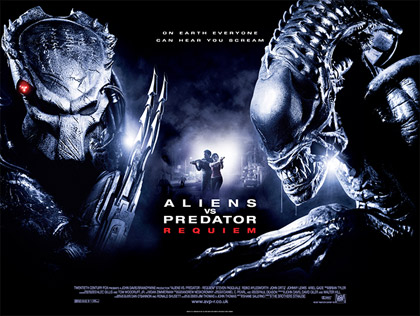
Reception
Ratings
Argentina: 13
Australia: M
Canada (Ontario): R
Canada (Manitoba): PA
Canada (Maritime): R (1986)
18 (re-rating, 1999)
Canada (Quebec): 13+
Chile: 14
Finland: K-16
France: 12
Germany: 16
Hong Kong: IIB
Iceland: 16
Ireland: 18
Japan: PG-12
Mexico: B
Netherlands: 16
Norway: 18
Peru: 14
Singapore: M18
Spain: 13
Sweden: 15
United Kingdom: 18
United States: R
Aliens was released in the US and Canada on 18 July 1986, and the 26 September in the same year in the
UK. It was released in Australia on 6th November It had a running time of 137 minutes. Eagerly anticipated by fans following the success of the original
Alien, it took $10,052,042 in its opening weekend in the US, and going on to take a box office total of $85,160,248 domestic and
$131,060,248
worldwide.
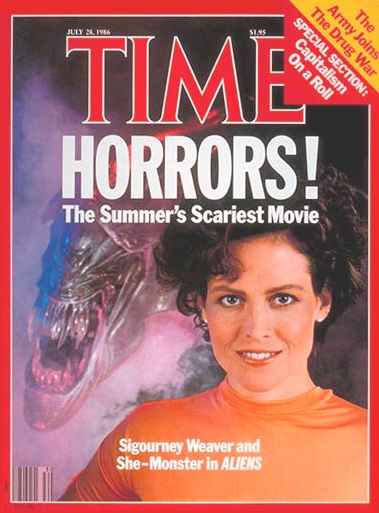
Aliens on the cover of TIME's July 28, 1986 issue.
Critical and audience reaction to the film was superb. Roger Ebert called it "painfully and unremittingly intense" and a "hair-raising carnival ride that never stops," but also praised Aliens as a "superb example of filmmaking
craft". TIME Magazine featured the film on the cover of its July 28, 1986 issue, in which reviewer Richard Schickel declared the film "a sequel that exceeds its predecessor in the reach of its appeal while giving [Sigourney] Weaver new emotional dimensions to
explore." TIME also detailed the development process of the film and the approach taken by its director and lead star. Rotten Tomatoes' survey of major reviewers received it as a
100%.
Other praise of Aliens included reviews calling it "one of the few cases of a sequel that far surpassed the original" (Amazon.com editorial
review) and "The most intense and satisfying piece of science fiction ever made" from local news (Blake Davis of KFOR Channel 4 News). In a 1997 interview, Sigourney Weaver herself stated that Aliens "made the first Alien look like a cucumber
sandwich."
In 2007, Entertainment Weekly named Aliens as the #2 best action movie of all time, behind only Die
Hard. In Rotten Tomatoes' analysis of top 100 science fiction films, Aliens ranks #10 among the best-reviewed science fiction films of all
time.
In 2004, Aliens was named #35 on Bravo's 100 Scariest Movie Moments for the facehugger attack towards Ripley; the original Alien was named #2 for the chestbuster
scene.
Awards and accolades
Aliens was nominated for seven Academy Awards and won two (Sound Effects Editing and Visual Effects). Sigourney Weaver received her first
Academy Award nomination (Best Actress) for this film. Although Weaver did not actually win, it was considered a landmark for a nomination for Best Actress to even be made for a science fiction / horror film, a genre usually given little recognition by the
Academy.
Special Edition
A Special Edition was released in 1992 on laserdisc and VHS that restored 17 minutes of previously deleted
footage. the most notable addition was a segment early in the film showing the colony on LV-426 just as the colonists first encounter the derelict alien
spacecraft which is infested with the alien eggs. Other notable scenes included the "sentry gun scene" in the operations
building, Ripley's discovery of her daughter's fate while she was
away, and a few other dialogue scenes between Ripley and the Marines. One of these exchanges provides Ripley's full name (Ellen Ripley). This version was then released on The Alien Legacy in 1999 on DVD. Both versions of the film were released together for the first time in the 2003 Alien Quadrilogy DVD box set and then later on the Special Collector's Edition
DVD.
Spin-offs
The success of Aliens spawned a comic book series of the same name, Aliens, along with a series of 12 Aliens novels.
Two games based on the movie were released by Electric Dreams in the 1980s for the
Amstrad CPC, the ZX Spectrum, and the Commodore 64 8-bit home
computer systems. In 1990, Konami released an arcade game, Aliens, based on the movie.
Further reading
The Complete Aliens Companion (by Paul Sammon, Harper Prism, 1998, ISBN 0-06-105385-6)
Beautiful Monsters: The Unofficial and Unauthorised Guide to the Alien and Predator Films (by David A. McIntee, Telos, 272 pages, 2005, ISBN 1-903889-94-4)
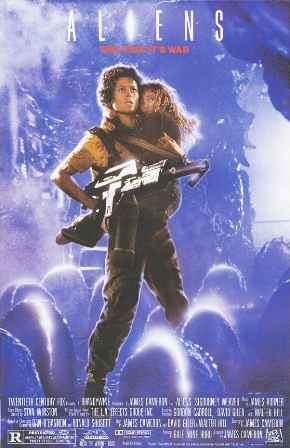
LINKS
and REFERENCE
-
Bernardin,
Marc (2007-06). The
25 Greatest Action Films Ever!. Entertainment Weekly.
-
100
Best-Reviewed Sci-Fi Movies. Rotten Tomatoes.
-
Richardson,
John H. "Iron Jim." Premiere Magazine, No. 12,
August 1994, p. 44-54.
-
IMDb
Award Listing. IMDb.com.
-
Imdb
business data. Imdb.com.
-
Movie
Franchises Index. Box Office Mojo (2007).
-
Schickel,
Richard (1986-07-28). Help!
They're Back!. TIME
Magazine. .
-
Cameron,
James. (Interview) Interview With James Cameron, Aliens
Special Edition DVD, 1986.
-
The
Alien Trilogy: A New Beowulf
-
Alien
Queen in Cameron's Aliens (1986).
-
Corliss,
Richard (1986-07-28). The
Years of Living Splendidly. TIME Magazine.
-
Paxton,
Bill. (Commentary) Aliens Special Edition DVD.
-
Aliens
Behind The Scenes, Aliens Special Edition DVD, Alien
Quadrilogy.
-
ABC
News: Arts and Entertainment article. www.abc.net.au. (and
DVD special features.)
-
Horner,
James. Alien Quadrilogy - Disc 4:Aliens: Bonus material -
Interview with James Horner.
-
Imdb
release dates. Imdb.com.
-
Cosford,
Bill. Let 'Aliens' Invade Your Peace of Mind. The Miami
Herald, July 18, 1986, pg. 1D.
-
Aliens
- Rotten Tomatoes reviews ratings. Rotten Tomatoes.
-
Roger
Ebert review. SunTimes.com.
-
Amazon.com
- Aliens Special Edition. Amazon.com.
-
Entertainment
Weekly -Beauty and the Beast
-
Bravo's
100 Scariest Movie Moments
-
Career
of living dangerously: Sigourney Weaver ready for next risk.
New York Daily News, Knight Ridder/Tribune News Service. March
21, 2001.
-
Aliens
- Special Edition details
Alien
movie trailer
A
- Z FILMS INDEX
A
- Z ACTORS INDEX
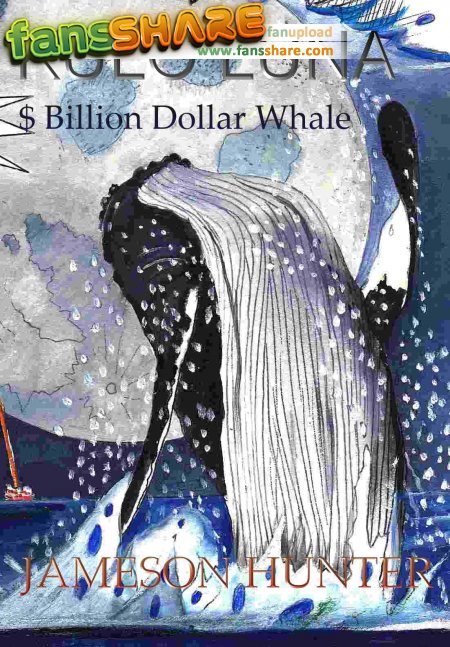
A
heartwarming action adventure: Pirate
whalers
V Conservationists,
introducing
John Storm and his solar powered robot ship
as
they fight to save a wounded whale from the sushi bars.
|
